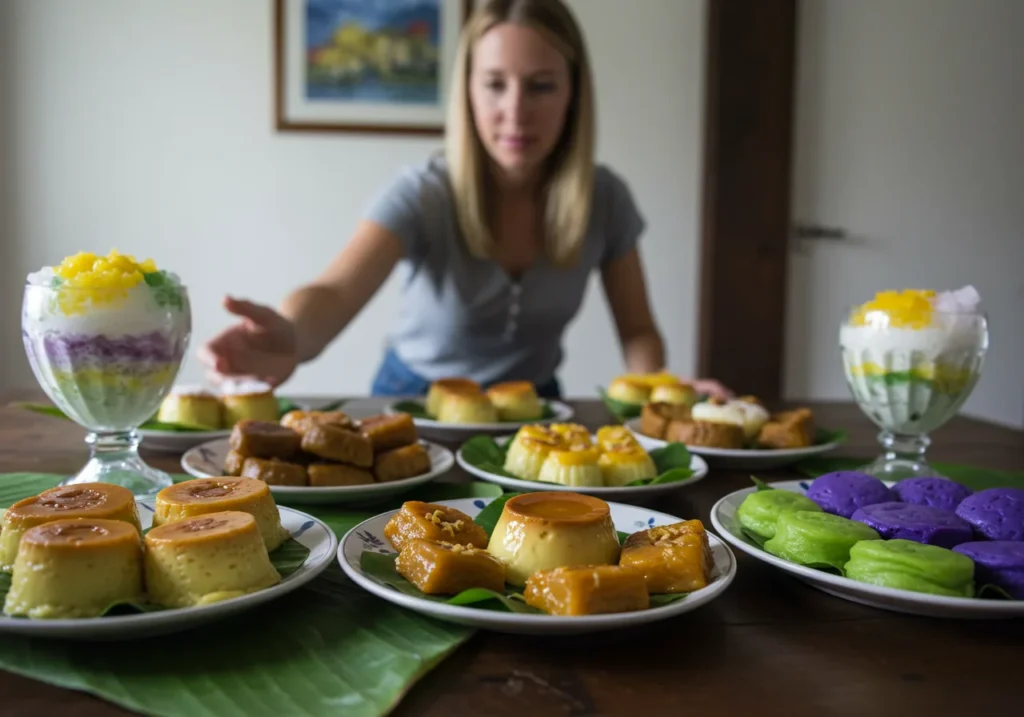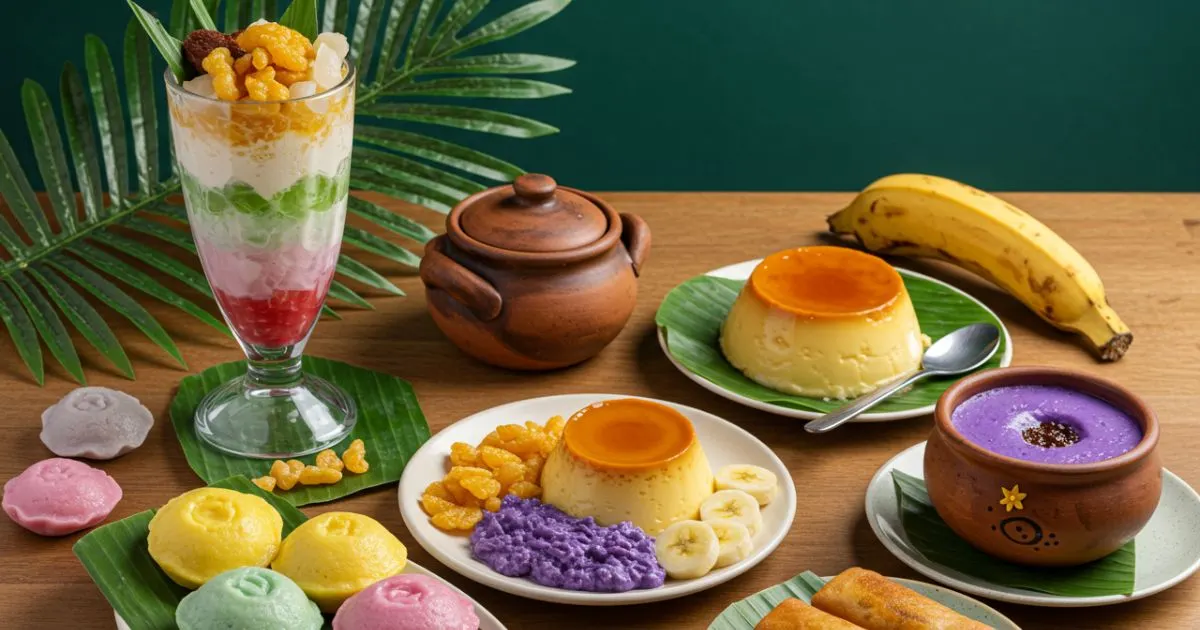Imagine stepping into a Filipino home, greeted by the intoxicating scent of freshly baked sweets wafting through the air. Filipino desserts aren’t just about satisfying your sweet tooth; they represent culture, hospitality, and the joy of sharing a moment with loved ones. Every dessert tells a story, whether it’s a treat passed down through generations or one that has evolved, absorbing influences from various cultures.
As you embark on this sweet journey through the world of Filipino desserts, you’re not just learning recipes—you’re experiencing a piece of the Philippines. Get ready to indulge in five mind-blowing Filipino desserts that will have you coming back for more.
Table of Contents
What Makes Filipino Desserts So Special?
Philippine confections are a remarkable mix of flavors, textures, and influences. Whether it’s the sweetness of coconut, the creaminess of ube, or the rich texture of rice, these desserts deliver a sensory experience unlike any other. Here’s why they stand out:
- Blending Flavors: Filipino desserts merge influences from local traditions, Spanish colonization, and Chinese immigrants. Ingredients like coconut milk, pandan, and sweetened condensed milk are staples that make these treats rich and diverse.
- Texture Matters: From the chewy consistency of biko to the silky smoothness of leche flan, texture plays a key role in the enjoyment of Filipino desserts. You’ll find an array of textures in one dessert—crispy, soft, creamy, and chewy.
- Sweet and Balanced: Filipino sweets aren’t overpowering in sugar. Instead, they strike a perfect balance, making them perfect for those who love a moderate sweetness that doesn’t overwhelm.
5 Filipino Desserts That Will Blow Your Mind
Anticipate a collection of Filipino treats that will have your taste buds rejoicing! These five sweets are beloved for their flavors, textures, and rich cultural roots. Each one tells a unique story, and trust us, they’re all irresistible.
1. Halo-Halo: The Ultimate Filipino Summer Treat
The first dessert that likely comes to mind when you think of Filipino treats is halo-halo. This bright and invigorating dessert is the ideal Filipino delight for the summer season. Perfect for cooling off, it’s packed with an exciting mix of crushed ice, various sweet beans, fruits, and jellies and topped with a scoop of creamy ube ice cream. Here’s what makes it so special:
- Layers of Flavor: Halo-halo is all about balance—each layer offers a different texture and flavor, from sweet beans to chewy gulaman (jelly).
- Adaptability: The appeal of halo-halo is that you can modify the ingredients according to your liking. Want more ube? Add it! Craving extra beans or fruits? Go ahead.
- A Celebration of Filipino Ingredients: This dessert brings together ingredients that are distinctively Filipino, like langka (jackfruit), sweetened beans, and the iconic ube ice cream.
Halo-Halo Recipe
| Ingredients | Quantity |
|---|---|
| Crushed Ice | 1 cup |
| Sweetened Red Beans | 1/4 cup |
| Sweetened Jackfruit | 1/4 cup |
| Sweetened Coconut | 1/4 cup |
| Leche Flan | 1 small slice |
| Ube Ice Cream | 1 scoop |
| Pandan Jelly | 1/4 cup |
| Sugar (optional) | 1 tsp (optional) |
Instruction
- Place the sweetened beans, jackfruit, coconut, and pandan jelly in layers inside a tall glass.
- Fill the glass with crushed ice.
- Finish with a slice of leche flan and a scoop of ube ice cream on top.
- Mix and enjoy the tropical delight!
2. Ube Halaya: Creamy Purple Delight
A favorite among Filipino desserts, Ube Halaya stands out with its vivid purple shade and creamy, velvety feel. This dessert highlights ube (purple yam), a root vegetable that holds an important place in Filipino culinary traditions. Thanks to its rich taste, it’s excellent by itself as a dessert or as a filling for cakes and pastries.
- Sweet and Smooth: Ube halaya is naturally sweet with a creamy consistency that’s perfect for spreading on toast or eating by the spoonful.
- Versatility: You can enjoy ube halaya on its own, as a filling for pastries, or even as an ice cream base. It’s one of those desserts that can be customized in numerous ways.
Ube Halaya Recipe
| Ingredients | Quantity |
|---|---|
| Ube (grated) | 2 cups |
| Coconut Milk | 1 can (400 ml) |
| Sweetened Condensed Milk | 1 can (300 ml) |
| Sugar | 1/2 cup |
| Butter | 1/4 cup |
| Vanilla Extract | 1 tsp |
Instruction
- Add the grated ube, coconut milk, and condensed milk to a pan and heat them on medium.
- Stir continuously to prevent sticking.
- As soon as the mixture thickens, stir in sugar, butter, and vanilla extract. Stir until smooth.
- Transfer to a dish and refrigerate until set. Enjoy this creamy treat!
3. Leche Flan: Filipino Caramel Custard
This rich, decadent custard dessert has deep roots in Filipino culture. With its creamy texture, leche flan is made from eggs, milk, and sugar and is crowned with a glossy caramel layer. It’s the perfect dessert for special occasions, often served at weddings, birthdays, and holidays.
- Perfectly Sweet: Leche flan is deliciously rich but not too sweet. The caramelized sugar adds a subtle bitterness that complements the custard’s creamy texture.
- A Touch of Luxury: This dessert feels indulgent, which is why it’s often reserved for special occasions in Filipino households.
Leche Flan Recipe
| Ingredients | Quantity |
|---|---|
| Eggs | 10 large |
| Sweetened Condensed Milk | 1 can (300 ml) |
| Evaporated Milk | 1 can (300 ml) |
| Sugar (for caramel) | 1/2 cup |
| Vanilla Extract | 1 tsp |
Instruction
- Preheat your oven to 350°F (175°C).
- Over medium heat, melt sugar in a pan until it reaches a golden, caramelized state. Pour into a flan mold.
- Combine the eggs, condensed milk, evaporated milk, and vanilla by beating them. Pour over the caramelized sugar.
- Cook in a water bath for 60 minutes or until it is set. Ensure it has cooled down before storing in the refrigerator.
4. Bibingka: Filipino Rice Cake Delight
A cherished dessert in the Philippines, Bibingka is a rice cake prepared using rice flour and coconut milk, commonly topped with ingredients like salted egg or cheese. It’s a warm, comforting dessert that’s often enjoyed during Christmas but can be eaten year-round.
- Warm and Cozy: Bibingka is the perfect dessert for a cold day. The salty-sweet combination of cheese and salted egg makes it unique and satisfying.
- Tradition in Every Bite: Bibingka is often associated with Filipino Christmas traditions, where it’s served after attending Simbang Gabi, the Filipino version of a midnight mass.
Bibingka Recipe
| Ingredients | Quantity |
|---|---|
| Rice Flour | 2 cups |
| Coconut Milk | 1 can (400 ml) |
| Baking Powder | 1 tsp |
| Eggs | 2 large |
| Sugar | 1/2 cup |
| Salted Egg | 1 (sliced) |
| Cheese (grated) | 1/4 cup |
Instruction
- Preheat the oven to 350°F (175°C).
- Blend rice flour, coconut milk, baking powder, eggs, and sugar in a mixing bowl.
- Pour into a greased baking pan and top with salted egg and cheese.
- Bake for 30-40 minutes or until golden brown. Serve warm!
5. Buko Pandan: A Refreshing Coconut Dessert
This invigorating dessert merges the sugary flavor of young coconut with the aromatic scent of pandan. It’s delicate, luscious, and perfect for every occasion. For a tropical dessert experience, buko pandan is the one to taste.
- Smooth and Refreshing: Coconut, pandan, and sweetened cream come together to create a creamy dessert that’s great for warm days.
- Easy to Make: It’s a no-bake dessert that comes together in just a few simple steps, making it perfect for when you want a quick yet impressive treat.
Buko Pandan Recipe
| Ingredients | Quantity |
|---|---|
| Young Coconut (shredded) | 1 cup |
| Pandan Jelly | 1/2 cup |
| Sweetened Cream | 1/2 cup |
| Condensed Milk | 1/4 cup |
| Sugar | 2 tbsp |
Instruction
- Stir together the shredded coconut, pandan jelly, and sweetened cream in a bowl.
- Combine the condensed milk and sugar, stirring until fully integrated.
- Refrigerate for 2-3 hours, then serve chilled.
How to Enjoy Filipino Desserts: Tips and Pairings
Enjoying Filipino treats is usually most enjoyable in the presence of family and friends. Whether you’re sharing a bowl of halo-halo or cutting into a fresh bibingka, these treats are made to be savored and shared. Here are a few ideas on how to appreciate them:
- Serve Chilled or Warm: Some Filipino desserts, like halo-halo, are served chilled, while others, like bibingka, are best enjoyed warm. Make sure to serve them as intended to get the full experience.
- Perfect Pairings: Pair your dessert with a nice Filipino beverage, like sago’t gulaman (a sweet drink with tapioca pearls and jelly) or a hot cup of Filipino coffee.
- Cultural Connection: Filipino desserts are more than just food—they represent a connection to family and tradition. Experience them with others for full enjoyment.

FAQs
What is the most popular Filipino dessert?
Halo-halo is the most iconic and popular Filipino dessert, loved for its refreshing nature and mix of textures.
Can I make Filipino desserts without special ingredients?
Yes! While some ingredients like ube or pandan might be unique, you can often find substitutes or use readily available items like sweet potatoes or vanilla.
Are Filipino desserts delightful?
Filipino desserts have a perfect balance of sweetness. They’re not overpowering but are designed to satisfy your sweet cravings.
Conclusion:
Now that you’ve discovered some of the most mind-blowing Filipino desserts, it’s time to try them for yourself. From the refreshing flavors of halo-halo to the creamy richness of leche flan, Filipino sweets are a unique treat for any occasion. Whether you’re making these desserts at home or enjoying them at a celebration, they’re sure to satisfy your cravings and offer a taste of the Philippines.
Ready to indulge? Try making these desserts today and experience the sweet side of Filipino culture. Don’t forget to share your favorites with family and friends—they’ll be as amazed as you are by the vibrant flavors!

